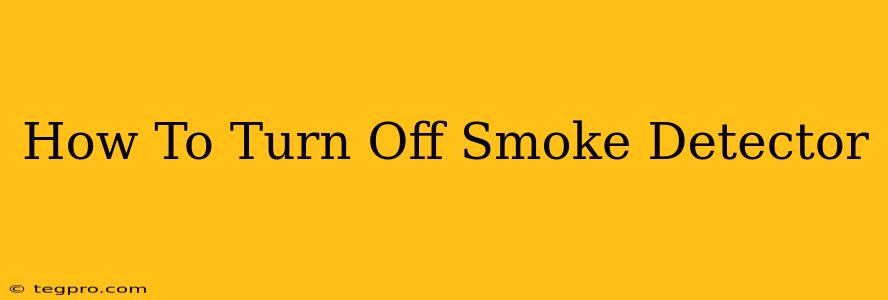A persistent beeping smoke detector can be incredibly irritating, but before you resort to drastic measures, understand that it's likely trying to tell you something important. This guide will walk you through how to effectively silence a smoke detector, addressing various scenarios and emphasizing safety.
Understanding Why Your Smoke Detector is Beeping
Before you even think about turning off the alarm, it's crucial to understand why it's beeping. This will help prevent future problems and ensure your home's safety. Common reasons include:
- Low Battery: This is the most frequent cause. The beeping is usually a steady, consistent sound.
- Dust or Debris: Accumulated dust or insects can interfere with the sensor. This might result in intermittent beeps or a persistent alarm.
- End of Life: Smoke detectors have a limited lifespan (typically 7-10 years). After this time, they should be replaced, even if they seem to be working fine. A beeping alarm could indicate it's nearing the end of its life.
- Actual Fire or Smoke: The most serious reason. A loud, continuous beeping signifies a potential emergency. Evacuate immediately and call emergency services.
- Power Outage (for interconnected systems): Some smoke detector systems are interconnected. If one loses power, the others might beep to alert you.
How to Silence a Smoke Detector (Safely)
The method for silencing your smoke detector depends on the cause of the beeping. Here's a breakdown:
1. Check the Battery
- Locate the battery compartment: This is usually on the back or side of the detector.
- Open the compartment: Use a screwdriver if necessary.
- Inspect the battery: Is it corroded, damaged, or simply old?
- Replace the battery: Use the correct type and size of battery specified in your detector's manual. Many use 9V batteries.
Important Note: After replacing the battery, wait a few minutes to see if the beeping stops. If it persists, move to the next steps.
2. Clean the Smoke Detector
- Turn off the power: If possible, turn off the power to the detector at the breaker box. This is a crucial safety precaution.
- Remove the detector: Carefully remove the smoke detector from the ceiling or wall.
- Clean the sensor: Use a soft brush or compressed air to gently remove any dust or debris from the sensor. Avoid using harsh chemicals or abrasive materials.
- Reinstall the detector: Once clean, carefully reinstall the detector, ensuring it's securely fastened.
3. Replace a Failing Smoke Detector
If the beeping continues despite battery replacement and cleaning, it’s time for a replacement. Do not attempt to repair an old smoke detector. Smoke detectors are critical safety devices, and their effectiveness diminishes over time. Replacing your smoke detector is a crucial home safety maintenance task.
4. Addressing a System Alarm
If you have interconnected detectors and one is beeping due to a power outage, you'll need to identify the source of the power issue. This might involve checking your circuit breakers or contacting your electrician.
Preventing Future Smoke Detector Problems
- Regular Testing: Test your smoke detectors monthly. Most have a test button.
- Battery Replacement Schedule: Replace batteries annually, or as recommended by the manufacturer. Don't wait until it starts beeping.
- Regular Cleaning: Clean your smoke detectors at least twice a year, especially in kitchens and areas prone to dust accumulation.
- Replacement Schedule: Replace your smoke detectors every 7-10 years, regardless of their apparent functionality.
By following these steps, you can effectively address a beeping smoke detector safely and efficiently. Remember, your safety and the safety of your family are paramount. If you're unsure about anything, it's always best to consult a qualified electrician.

